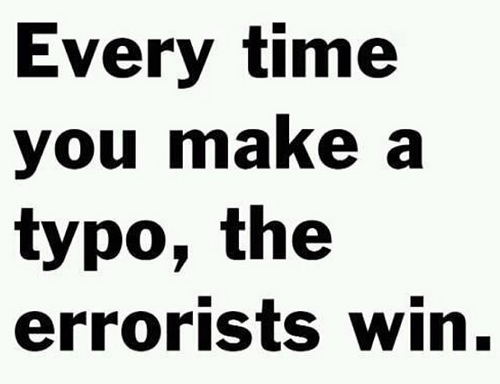 Writing is mianly about maening.
Writing is mianly about maening.
In an interview with Wired, University of Sheffield psychologist Tom Stafford explained:
“When you’re writing, you’re trying to convey meaning. It’s a very high level task.” A writer who leaves a lot of typos on the page is not being stupid or careless. Rather, he’s being rather smart. Our brains generalize simple, component parts—like turning letters into words and words into sentences—so it can focus on more complex tasks, like combining sentences into complex ideas. “We don’t catch every detail, we’re not like computers or NSA databases,” said Stafford. “Rather, we take in sensory information and combine it with what we expect, and we extract meaning.” When we’re reading other peoples’ work, this helps us arrive at meaning faster by using less brain power. When we’re proof reading our own work, we know the meaning we want to convey. Because we expect that meaning to be there, it’s easier for us to miss when parts (or all) of it are absent. The reason we don’t see our own typos is because what we see on the screen is competing with the version that exists in our heads.
Cambridge University published an interesting research explaining the brain activity about this.
“Aoccdrnig to a rscheearch at Cmabrigde Uinervtisy, it deosn’t mttaer in waht oredr the ltteers in a wrod are, the olny iprmoetnt tihng is taht the frist and lsat ltteer be at the rghit pclae. The rset can be a toatl mses and you can sitll raed it wouthit porbelm. Tihs is bcuseae the huamn mnid deos not raed ervey lteter by istlef, but the wrod as a wlohe.”
Translation:
“According to a researcher (sic) at Cambridge University, it doesn’t matter in what order the letters in a word are, the only important thing is that the first and last letter be at the right place. The rest can be a total mess and you can still read it without problem. This is because the human mind does not read every letter by itself but the word as a whole.”
The trick with editing, then, is to de-familiarize yourself with your words as much as possible. Stafford says that you should change the font, switch out background colors, or print the thing out and carve it up with a pen—all these things help communicate to your brain that it needs to pay attention.
Otherwise you could be coasting into errors, Stafford says. “Once you’ve learned something in a particular way, it’s hard to see the details without changing the visual form.”
I would add using a “text-to-speech” program to read the document back to you. And, if you can afford it, use an online proofreading service.

Recent Comments